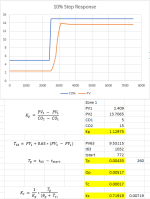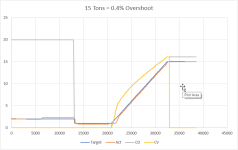Taylor Turner
Member
I want to share a trick and see if anyone can do better!
With hydraulic presses there is a point at the beginning of the actuator movement when it's pressing against air and the part/tooling has not been met yet. Then when the part/tooling has been met by the actuator, a big nasty pressure spike happens. How can we handle this?
I always have a programmed slow down position to allow a full throttle start; Customers always have a cycle time. A regenerative circuit is enabled at this point in time. Then at a position, the regen circuit is disabled and the analog pressure reducing valve is reduced to an appropriate pressure to meet the part/tooling. PROBLEM! acceleration is in the equation F=MA. You still get a pressure spike. I thought I was wise to just extend as slow as I possibly can and gently, perfectly meet the part; Customers always have a cycle time. It is always too slow.
I need high velocity and low force, so how can M be as small as possible?
Hit the part in regen at the low pressure analog signal.
The mass/pressure will be reduced by the ratio of the cylinder's cap and rod side areas and in turn the rod side will act against the cap side.
I have had hydraulic circuits that are riddled with relief valves to catch pressure spikes, but this has the best result I have seen in application. Nothing special, but is there better?
PS: I monitor velocity to kick out of regen an start the pressure control.
With hydraulic presses there is a point at the beginning of the actuator movement when it's pressing against air and the part/tooling has not been met yet. Then when the part/tooling has been met by the actuator, a big nasty pressure spike happens. How can we handle this?
I always have a programmed slow down position to allow a full throttle start; Customers always have a cycle time. A regenerative circuit is enabled at this point in time. Then at a position, the regen circuit is disabled and the analog pressure reducing valve is reduced to an appropriate pressure to meet the part/tooling. PROBLEM! acceleration is in the equation F=MA. You still get a pressure spike. I thought I was wise to just extend as slow as I possibly can and gently, perfectly meet the part; Customers always have a cycle time. It is always too slow.
I need high velocity and low force, so how can M be as small as possible?
Hit the part in regen at the low pressure analog signal.
The mass/pressure will be reduced by the ratio of the cylinder's cap and rod side areas and in turn the rod side will act against the cap side.
I have had hydraulic circuits that are riddled with relief valves to catch pressure spikes, but this has the best result I have seen in application. Nothing special, but is there better?
PS: I monitor velocity to kick out of regen an start the pressure control.





